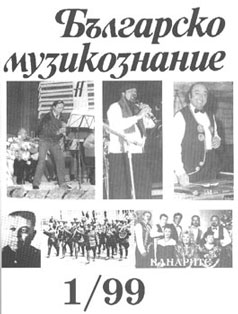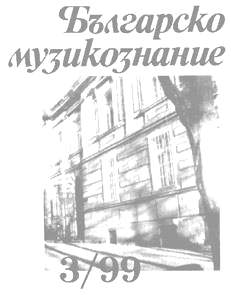
| General info | Administration | Departments | Libraries | Journals | Folklore Database | Links |


MATERIALS FROM THE PROJECT
“INFORMATION -THEORETICAL
SYSTEMS
AND MUSICAL PRACTICES (1999-2001)”
Lubomir Kavaldjiev
Prefase by editor (p. 3)
Bozidar Karastojanov
Structural Units of the Second
Level in Monody and their Formulaic Realizations (p. 5)
Elisaveta Valtschinova-Tchendova
Genre Models in Bulgarian Composers’
Works During the Last Three Decades (p.16)
Rossitsa Draganova
Mailing Lists or Melomanic in
the Conditions of Internet (p. 64)
Lubomir Kavaldjiev
Electro-acoustic Musical Practice
in Bulgaria: Specifics and Approaches (p.82)
Rossitsa Draganova
World Wide Web or About Open
and Reduced Information Models (p. 92)
 To Top
To Top
Claire Levy
Music and Technology: New Research
Accents (p. 106)
Angelina Petrova
Genre Models in Bulgarian Composers’
Works During the Last Three Decades (p. 113)
Angelina Petrova
Structural Units of the Second
Level in Monody and their Formulaic Realizations (p. 116)
Claire Levy
On „Otherness”: The Metaphors
of Yildiz Ibrahimova in her „Balkantolia” (p.118)
Petia Zlatanova
On the Culturological Typology
of Bulgarian Electronic Music. Four Profiles (p.136)
 To Top
To Top
The traditional idea of the formulas in "Znamenen rospev"
of the so
called popevki and fiti develops into a concept of
complete regulation
of the melody. The formulaic realizations have all
melodic units also
including the motifs forming the popevki and fiti.
The task to finds the formulas called kokizniki and
fitnichi was set in
the past. Now the object of systematizing are the motif
formulas, the
samples of which are noted down with flag notation
and transcription,
included in tables.
 To Top
To Top
1. Characteristic genre features of contemporary Bulgarian
music
The individual author’s approach determines, on the
one hand, the lack
or the level of the specific "primary" refraction of
the phenomena from
the world musical practice, on the other hand – their
secondary
re-creation through already established traditions
in Bulgarian music.
Generally these trends do not exist in pure form –
their interweaving
leads to various artistic results. Conscious deviation
from the
traditional genre code is characteristic for a number
of the leading
models. The genre model that has been accepted as a
basis may belong to
forms recognized for centuries, but it may have been
created in our
lifetime. In this respect, the original author’s genre
code mostly bears
the sign of innovation.
The attitude to Bulgarian musical folklore is an opportunity
of joining
Bulgarian authors to the European tendencies from the
second half of XX
century and achieving creative identity in the post-modern
situation of
disintegrating vanguard.
The transformation of the idea of sound and musical
time reflects upon
the preservation/renovation of genre. The composition
experiments with
time continuum and the transformations of sound affect
both the increase
in the possibilities of acoustic instruments and the
sounds obtained
through the new electric-acoustic technique. Electronic
music is
particularly interesting a new genre trend.
"The planning of composers’ work in the past and at
present is evident
in the great variety of composition solutions of the
members of the
Union of Bulgarian Composers at the reviews of "New
Bulgarian Music".
The presence of tradition is supported by the authors
through a
conscious approach to continuity, in which the system
of genres is
essential.
2. On some genre approaches
The chamber character of the opera genre is characteristic
for the
musical stage works. The relation with the symphonic
orchestra and
chamber-instrumental principles of development and
the interaction with
cantata-oratorio, with conventional theatre are increased.
Chamber
operas and works for children predominate. The contemporary
dance
theatre and vanguard theatre offers interesting genre
solution. The
popular musical stage genres are based on the comparison
with world
genre models and stylistic standards, adopted in this
country through
performance and mass media practices.
In orchestra and instrumental music a tendency is
evident towards a
chamber character of symphonic thought. Symphonies
for chamber, string
and wing orchestras, concertos for orchestra have become
genre models.
Another trend is "the big symphony’. In a number of
works, however, it
is very difficult to point out the exact genre formulation
characteristic for them, although their names suggest
their genre
belonging.
3. Interpretations of genre models in descriptions of Bulgarian
composers’ works
The structuring of the works according to their genre
features assumes
the existence of a theoretical model, which is in conformity
with stable
models, recognized in theoretical musicology as well
as with the
specifics of the individual creative expression. The
chronological
approach and the genre approach complement each other,
and the accent on
one of them depends on the task, set by the researcher
– a historian or
a theoretician. A more complex and at the same time
a more
representative scientific task is the attempt to study
their
interweaving.
 To Top
To Top
The study aims to analyze and interpret the discussions
of music in
mailing lists and especially the stream of fans’ evaluations
attracting
huge publicity now in the conditions of virtual reality.
Both the
analysis and the conclusions about the cognitive peculiarities
of
melomania are based on the material of a common Francophone
list of
discussions in the field of classical music. It is
emphasized that the
amateur knowledge of music is based mainly on concrete
individual
perceptive experience; presented as an end in itself
, without any link
with one’s experiences and/or the reflection of the
beauty of music,
scientific truth remains without response, it does
not excite the
melomaniacs, it does not change their cognitive and/or
axiological
inclinations. Another virtual phenomenon is discussed
too: the music
fans’ webs for music which satisfy a new need – the
need for
objectifying the passion for music in the forms of
the multimedia and in
the space of WWW; the need for carrying out a specific
reflexive
activity in the conditions of contemporary informational
life.
 To Top
To Top
The practice of contemporary Bulgarian electric-acoustic
is analyzed in
some of its informational and theoretical, psychological
and aesthetic
aspects with a view to its being included in information
systems of
various types and purpose.
Contemporary electric-acoustic music is defined as
artistic activity,
in which sound creation and specific professional musical
skills and
innovations predominate, even when the product contains
elements from
other arts or activities (text, graphics, video). It
is predominantly
instrumental music, the use of the human voice is admissible,
but the
figure of the singer as a rule does not identify it
before the listeners
as is often the case in pop and rock music. In it the
principal thing is
the creative work with sound (sound design) and space
(stereo, quadro,
surround), which frequently predetermines the character
of the
composition itself. The creative (non-standard) use
of electronic and
computer technique is obligatory in these processes
as well as in the
final presentation in a studio or live performance.
Along with
synthesizers, electric guitars, and computer generators
of sound, the
electric-acoustic music today also uses traditional
sources: human
voices, classical, folklore or exotic instruments,
sounds from nature or
the urban medium, but they have to pass through essential
treatment with
computers or other devices of contemporary electric-acoustic
technique.
This is one of the principal reasons to call this music
electric-acoustic unlike the traditional purely electronic
music of
vanguard character.
 To Top
To Top
The article presents the types of information about music
in World Wide
Web and formulates two basic principles for its structuring.
The model
identification is based mainly on the analysis of several
Bulgarian web
sites for Bulgarian music among which is prominent
the web site of the
multimedia database for Bulgarian folklore music,
realized by a team of the Institute for Art Studies
at the Bulgarian
Academy of Sciences. The first principle that the sites
are open is
determined as a compensatory mechanism against the
very depth of
information as endless/variable, insufficient as well
as a specific
corrective measure of the deceptive aspiration for
thorough data. The
second principle defines the thematic/axiological reductions
in the
sites. How the limiting of the information fields interacts
with the
idea of World Wide Web as inexhaustible/multi-layer
source of
information and with the view on Music as a category
concept is being
analyzed, and the specific even paradoxical freedom
of virtual behaviour
in the conditions of reduced thematic/axiological complementarity
is
being formulated.
 To Top
To Top
The study argues on the changing attitudes towards the
different/exotic,
seen in the context of a seemingly homogenizing global
culture. Drawing
on the concepts of multiculturalism and aesthetical
non-centrism
observed in different fields of contemporary music,
the analysis
presents the personal artistic understanding for the
freedom in music as
seen by the female Bulgarian-born jazz singer of Turkish
descent Yildiz
Ibrahimova. The attention is focused on her 1997 album
Balkanotolia
(labeled as ethno-jazz) and its specific nonverbal
metaphors aiming to
tackle frozen categories of the self-other dichotomy
by combining and
interpreting specific Bulgarian and Turkish folk material
from the
pre-supposed „common Balkan stock".
 To Top
To Top
The article presents, on the basis of terrain musical-anthropological
study, typological characteristics of four figures
in Bulgarian
electronic music, who are representatives of different
creative
generations. Ilia Fortunov comes from rock music due
to thorough work on
the guitar sound. Liubomir Kavaldjiev is a musicologist,
a philosopher,
a multi-media aesthete, presumably a representative
of the academic
community, by nature – a typical representative of
the Third Information
Wave. Vlatimir Djambazov is a follower of the traditional
analytical
European conception of "Elektronische Musik" in a vanguard
and
post-vanguard light. Ivan Dragolov is an interesting
example of
purposefully laconic, but highly precise quests in
programming
algorithmic music.
The respective profiles of the four authors are also
outlined according
to the functional model TIEM.
After presenting the four models of musical behaviour
some basic
aesthetic properties of the innovational electronic
music in Bulgaria
are worked out.
- Superhuman message /supernatural, magic/, subconscious,
implicit – as
frequently met categories in the aesthetics of Bulgarian
electronic
music.
- Innovational quests and antagonistic attitudes to
already created
rules and norms (projection of Vanguard).
- Tendency towards using various devices from other
arts – cinema,
theatre, ballet, mimicry and gestures.
- Developing TEAM SENSE, as part of globalization within
the context of
world culture and PROJECTION OF THE IDEA OF DECENTRALIZATION
in the
third informational wave /after A.Toffler/.
 To Top
To Top
3. ARCHIVE:
1.Covers '99


2. Table of Contents (German Version) & Abstracts (in German or English)
2002 Book 3| General info | Administration | Departments | Libraries | Journals | Folklore Database | Links |
 To Top
To:
BULGARIAN ACADEMIC MUSIC PORTAL
To Top
To:
BULGARIAN ACADEMIC MUSIC PORTAL